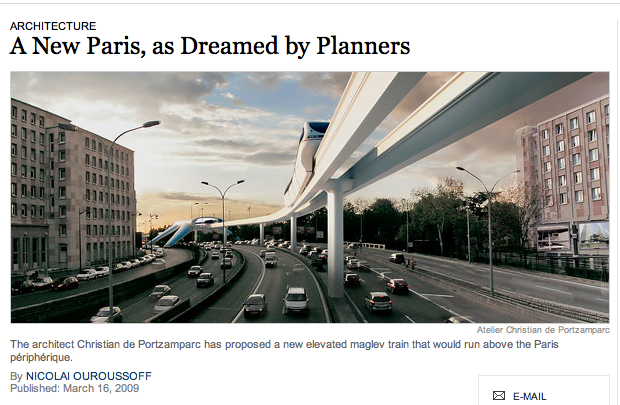A New Paris
Article publié le : Jeudi 26 mars 2009. Rédigé par : Nicolas Vargelis New York Times, March 17, 2009
New York Times, March 17, 2009
A New Paris, as Dreamed by Planners
By NICOLAI OUROUSSOFF
PARIS — Hand it to the French. Who else would pick an economic collapse as a time to unveil one of the most audacious urban plans in recent memory?
Yet the 10 proposals for a new master plan for metropolitan Paris, which were unveiled last week, may just be the kind of brazen idealism the world needs right now.
The results of a nine-month study commissioned by President Nicolas Sarkozy, the proposals aim to transform Paris and its surrounding suburbs into the first sustainable “post-Kyoto city,” a reference to the treaty on climate change, with an expanded Métro system and sprawling new parks.
The government has yet to say how it would raise the money to build this new city. And Mr. Sarkozy’s opponents, who have sometimes dismissed him as “President Bling-Bling,” have questioned whether this is anything more than an elaborate publicity stunt.
But even if none of the proposals are ever built, they show a daring that has not been seen in a Western city for decades. The teams range in experience from well-established international stars like Richard Rogers and Christian de Portzamparc to French architects who are just beginning their careers. All forsook flashy imagery for a deep analysis of the city’s diverse communities and the fraying tissue that binds them together. At the very least, the results should force a radical reappraisal of Paris’s identity. The enchanted city most of us know through holidays and films is a compact metropolis of roughly two million people that lies within the périphérique, the elevated freeway that encircles the old city. Its pretty medieval streets and broad boulevards are held up as a model of the ideal city.
But for decades the vast majority of Parisians have lived in the generic apartment blocks and squalid housing projects that make up most of the suburbs. These include the poor immigrant neighborhoods that erupted in violence in 2005.
The aim of the study was twofold: to create a plan for a greener, more sustainable city, and to break down the isolation between the outlying neighborhoods and the historic center. The most thought-provoking designs operate on multiple levels, reaching beyond the issue of sustainability to address deeply entrenched social ills.
Among the most audacious is Mr. de Portzamparc’s plan, which proposes demolishing both the Gare du Nord and the Gare de l’Est and replacing them with a single massive European train station just outside the city center. The station would link to the Eurostar train lines to London and Brussels, as well as to a new elevated maglev train that would run above the périphérique. It would also anchor a towering new global business district, a rival to La Défense.
Mr. Rogers’s plan is equally ambitious. Noting that the tracks that connect to the city’s main train stations cut Paris into wedges, like slices of a pie, he proposes burying them all underground. A vast system of public parks would be draped over these new underground tracks, connecting poor and middle-class neighborhoods. A new Métro line would ring the outer city; more trains would tie the system back to the historic center.
Other plans are more poetic. Jean Nouvel proposes creating a green belt that would circle the entire city. All future construction would be concentrated inside this belt, adding density to what are now sprawling, isolated communities. New towers would punctuate some of the outlying boulevards, adding visual markers where there are none. The outer ring would become a sort of 620-mile-long community garden, with residents tending their plots along an endless string of parks and fields. The idea is to give a powerful identity to the most anonymous parts of the city.
And then there are the usual provocateurs. Djamel Klouche, at 42 the youngest of the participants, has proposed transforming the space underneath the Louvre pyramid into a bustling Métro hub, making one of Paris’s greatest cultural monuments the main entry point to the city center for its immigrant masses. The Paris-based Roland Castro suggests moving existing monuments, including the Élysée Palace, to the city’s grittiest outlying neighborhoods.
Yet all of the projects recognize the strong link between urban policy and social equality. In tying environmental concerns to issues of identity, they suggest ways to begin reversing the growing social divisions that mark the contemporary city. If they inspire a broader global debate on these tensions, they will already have accomplished something of significant value.
Nicolas Vargelis

















